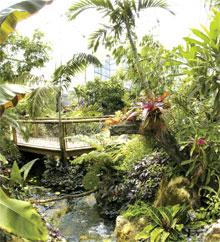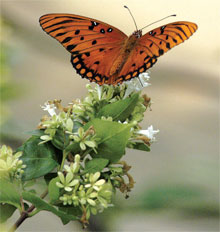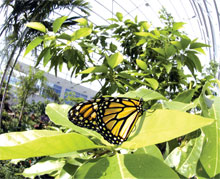


By Karin Fabry
At any given time, there are more than 2,000 butterflies fluttering about the Museum of Natural History in Gainesville. A bubbling waterfall gurgles and churns in the corner of the two-story screen enclosure that houses the butterflies. Tropical and sub-tropical foliage in all shapes and colors adds to the rainforest atmosphere of the museum’s newest exhibit.
“I’ve been working on this project in one way or another for 20 years,” says Director Thomas C. Emmel. “I’m very excited that this is finally a reality. It’s been a long time coming.”
The Butterfly Rainforest is the only facility in the world dedicated entirely to the research and education of butterflies and moths. Once the complete collection is in place, it will be the second largest in the world, exceeded only by the Natural History Museum in London. I was able to get an early tour of the facility before the grand opening on August 14.
It’s not just another Florida attraction,” says UF Entomology Professor Andrei Sourakov. “It has educational value as well. Visitors will see butterflies feeding, flying, even sleeping in the rainforest. When I think of how to describe the exhibit, the word wow! comes to mind.”
And wow is right. The exhibit features a 6,400-square-foot butterfly enclosure with waterfalls and a 400-foot trail. Beautiful plants were blooming in vibrant shades of pink, purple, and yellow, and the fragrant exhibit made me feel like I was surrounded by a thousand bouquets of blossoming flowers.
“Everything in the exhibit is real,” Sourakov explains. “I personally like all of the elaborate rock work. The idea was to recreate the rainforest, and Bruce Morgan, who designed and created everything but the big cage, tried to create an ecosystem that would rival the butterflies’ natural habitat.”
And as a Monarch butterfly drifts by, Sourakov adds, “and I think the butterflies act quite naturally here. They feel very much at home.”
In the wild, a butterfly lives in average of seven to 10 days. In captivity, butterflies are capable of living for two to three weeks. But some species that modify their nectar diet to include other nutrient sources can live as long as three to six months.
“Depending on what time visitors are here,” Sourakov says. “They’ll witness different butterfly behaviors. In the morning, the butterflies may feed on nectar; in the afternoon, mating is a common activity; and people who are here towards the evening may even witness the butterflies sleeping in their assemblages, where many butterflies sleep together in one place.”
Darcie MacMahon, the exhibits director for the museum, is excited to have a live exhibit for guests to explore.
“We don’t often have a collection of living animals at our museum,” she says. “There’s still so much we don’t know about butterflies. We hope to get children interested in the field. Who knows, maybe we’ll produce the next generation of scientists who will discover many unknown butterfly species.
“It really brings history and science to life,” she concludes.
As guests explore the butterfly exhibit, it quickly becomes apparent that work is being done — right before their eyes.
“A lot of research will take place on site and behind the scenes,” Sourakov says. “The scientists have become a part of the display. I guess they have to come to work with a smile on their face,” he jokes.
“There are 20,000 known species of butterflies, and ten times more moths, and new species are being discovered all the time,” Sourakov continues. “There is still a tremendous amount of work to be done.”
One of several on-site laboratories is the rearing lab where butterfly pupa will evolve into butterflies.
“The majority of the butterflies in the rainforest will be received from butterfly farms throughout the Americas and Asia, specifically Malaysia, the Philippines, Costa Rica, Ecuador, and Florida,” Sourakov explains. “The rearing lab will raise some species of butterfly, particularly for larval display, but not with the intent to increase the population in the rainforest. The rearing lab will allow visitors an up-close look at the cycle of the butterfly.”
There are also labs dedicated to molecular genetics, physiology, specimen preparation, and more.
“Our original goal was to build a second-to-none research facility and we’ve done that,” Emmel says.
At the same time, the exhibit has been made both fun and informative for museum visitors. The public area will feature nine large, colorful, information panels that explain each species life cycle, coloration, mating habits, and metamorphosis. Next to each panel, collection drawers will house thousands upon thousands of real samples.
“Enlarged photos will allow people to see the details of the specimens,” Sourakov says. “A lot of labor was involved with cutting out, mounting, and labeling each specimen.”
Another area worth noting is the Wall of Wings, which extends 21 feet high and 200 feet long. The wall will contain thousands of scanned images, information panels about butterfly and moth biology, and plasma video screens featuring live footage of butterflies from different parts of the world.
Adjacent to the Wall of Wings is the World of Wings map wall featuring stories of how butterflies contribute to biological sciences research around the globe.
Worth noting is the fact that the acronyms of both of these expansive new displays literally spell out a one-word summary of Gainesville’s Butterfly Rainforest.
WOW, indeed!
Butterfly Rainforest
Florida Museum of Natural History
University of Florida Cultural Plaza
SW 34th Street and Hull Road, Gainesville
352-846-2000
www.flmnh.ufl.edu
Hours:
10am-5pm, Monday-Saturday
1-5pm, Sunday
Admission is free






